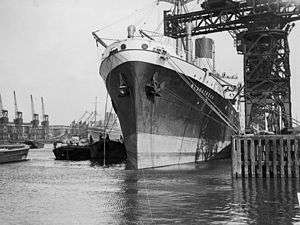Blue Funnel Line
Alfred Holt and Company, trading as Blue Funnel Line, was a UK shipping company that was founded in 1866 and operated merchant ships for 122 years. It was one of the UK's larger shipowning and operating companies, and as such had a significant role in the country's overseas trade and in the First and Second World Wars.
It's seafarers later went to fill various roles in the British maritime shore based establishment, including Malcolm Machlachlan, a lecturer in Glasgow and a popular author of books on Maritime business.[1]
History
Alfred Holt founded the business on 16 January 1866.[2] The main operating subsidiary was the Ocean Steam Ship Company, which owned and operated the majority of the company's vessels.
A Dutch subsidiary, the Nederlandsche Stoomvaart Maatschappij Oceaan, was founded in 1891, as was the East India Ocean Steam Ship Company, operated from Singapore. This latter was sold in 1899 to Norddeutscher Lloyd. The company acquired the competing China Mutual Steam Navigation Company in 1902, keeping it as a subsidiary company but operating it as part of Blue Funnel Line.
Ships of the Blue Funnel fleet all had names from classical Greek legend or history.[3] The majority were cargo ships, but most of the Ocean SS Co cargo ships also had capacity for a few passengers.[3] The line also had a small number of purely passenger vessels.[4]
Nestor, launched 7 December 1912,[5] and Ulysses, launched 5 July 1913,[6] are examples of large cargo/passenger vessels entering the line's service at the time. Both ships were built in Belfast by Workman, Clark and Company with a length of 580 ft (176.8 m) and 14,500 gross tons.[5][6] Passenger accommodations were for first class only and seven cargo holds, one and a 'tween decks space fitted for refrigerated meat, dairy and fruit cargoes, provided accommodation of the largest consignments.[5][6]
In the 1920s, Blue Funnel became the first British shipping company to employ a woman marine engineer. Victoria Drummond served with the company three times: firstly as Tenth Engineer on the liner Anchises 1922–24,[7] then as refrigeration engineer on the refrigerated cargo ship Perseus in 1943[8] and finally as resident engineer at Caledon Shipbuilding in Dundee supervising the completion of Rhexenor and Stentor in 1946.[9] These were two of the first new ships built for Blue Funnel to replace its Second World War losses.[10]
Post World Wars
Blue funnel lost 16 ships in the First World War and 30 in the Second. After each war it restored its fleet with new ships. After the Second War it regained tonnage rapidly by buying six Victory ships from the United States Maritime Commission in 1946 and eight "Sam-" ships from the Ministry of War Transport in 1947.[10]
Two Blue Funnel ships, MS Agapenor and MS Melampus were trapped by the Six-Day War of 1967 and became part of the Yellow Fleet in the Great Bitter Lake, remaining there until 1975.
Closure in 1988
From 1947 to 1970, as Britain's empire began to shrink, so did its trade. Meanwhile, companies from other parts of the world began to operate more competitively. Cabotage regulations prevented British flag companies from trading on routes that were previously their monopolies. These factors resulted in Blue Funnel's fleet to shrink.[11]
The company finally came to an end in 1988 when Ocean Group withdrew from the Barber Blue Sea Service, its last shipping line. The Merseyside Maritime Museum Archive and Library holds the company archive.[12]
References and sources

- References
- ↑ Malcolm, Ian M (16 December 2013). Outward Bound: Blue Funnel Line (British - post ww2) (Merchant Navy Series Book 1). Dundee: Moira Brown.
|access-date=requires|url=(help) - ↑ "A History of Alfred Holt and Company" (PDF). Rakaia.co.uk. Archived from the original (PDF) on 5 February 2012. Retrieved 13 May 2008.
- 1 2 Talbot-Booth 1942, pp. 486–487.
- ↑ Talbot-Booth 1942, p. 487.
- 1 2 3 "Launches—Irish". International Marine Engineering. Marine Engineering, Inc., New York—London. 35 (January): 245. 1914. Retrieved 14 January 2018.
- 1 2 3 "Launches—Irish". International Marine Engineering. Marine Engineering, Inc., New York—London. 36 (August): 32–33. 1913. Retrieved 14 January 2018.
- ↑ Drummond 1994, pp. 75–110.
- ↑ Drummond 1994, pp. 208–220.
- ↑ Drummond 1994, p. 227.
- 1 2 Swiggum, Susan; Kohli, Marjorie (17 October 2010). "Blue Funnel Line". The Ships List. Susan Swiggum & Stephen Morse. Retrieved 18 September 2014.
- ↑ malcolm, Ian (16 December 2013). Via Suez (British): Blue Funnel Line (Merchant Navy Series Book 3). Liverpool: Moira Brown.
|access-date=requires|url=(help) - ↑ "Blue Funnel Line". Information sheets. Merseyside Maritime Museum Archive and Library.
- Sources
- Drummond, Cherry (1994). The Remarkable Life of Victoria Drummond – Marine Engineer. London: Institute of Marine Engineers. ISBN 0-907206-54-9.
- Talbot-Booth, E.C. (1942) [1936]. Ships and the Sea (Seventh ed.). London: Sampson Low, Marston & Co. Ltd. pp. 486–487.
- Books
- Cook, Ian (2010). Those in Peril: A Blue Funnel Story: a Fifty-six-year Love Affair with Ships. Christchurch, N.Z.: Willsonscott Publishing. ISBN 9781877427312.
- Falkus, Malcolm (1990). THE BLUE FUNNEL LEGEND. A History Of The Ocean Steam Ship Company , 1865-1973. London: Macmillan. ISBN 9780333522837.
Links
| Wikimedia Commons has media related to Blue Funnel Line. |
.jpg)